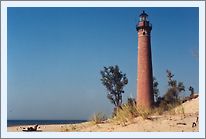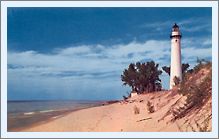|
Historical
Information

In the early 1800's western Michigan consisted of seemingly
endless forests, and with the skyrocketing growth of Chicago and
Milwaukee, it was inevitable that there would be those who would come to
the area to take advantage of the areas bounty. In the 1850's, Charles
Mears and Reverend William Ferry were both operating sawmills in the
area around Little Sable Point. While almost all of the pine forests had
been harvested by the 1880's, there were still plenty of hemlock and
hardwoods remaining.
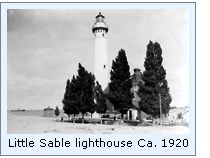 In the late 1860's Summers Fox, a local
merchant supplying the lumber trade began lobbying the Lighthouse Board
for the construction of a coastal lighthouse at what was then known as
Petite Pointe Au Sable. With the grounding of the schooner
"Pride" on Little Sable Point in 1871, cries for the
construction of a lighthouse swelled. In 1872, In the late 1860's Summers Fox, a local
merchant supplying the lumber trade began lobbying the Lighthouse Board
for the construction of a coastal lighthouse at what was then known as
Petite Pointe Au Sable. With the grounding of the schooner
"Pride" on Little Sable Point in 1871, cries for the
construction of a lighthouse swelled. In 1872,
O M Poe the Major of Engineers of the Eleventh Lighthouse District
wrote to the Lighthouse Board requesting that land for a lighthouse be
reserved in the area.
Congress appropriated $35,000 for the
project, and 39 acres of land were selected on which to construct the
new Light station. The construction of a light at Little Point Sable was
destined to be a daunting task, since the location was distant from any
area of supply, and there was a total absence of roads to the site. Work
began in April 1873 with the construction of a dock at the beach and
temporary housing for the construction crew.
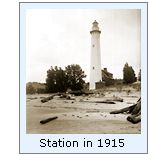 A
pile driver was towed to the point, and in accordance with Poe's plan, 109
one-foot diameter pilings were driven into the sand to a level nine feet
below the surface in order to form a solid base on which to build the
tower. Twelve feet of cut stone was then carefully laid atop the pilings to provide a solid base for the tower's brickwork. The brick
walls had a thickness of five feet at the base, tapering to a thickness
of two feet at its uppermost. With the advent of winter, the crews were
removed from the point, and work had to wait for the next spring. A
pile driver was towed to the point, and in accordance with Poe's plan, 109
one-foot diameter pilings were driven into the sand to a level nine feet
below the surface in order to form a solid base on which to build the
tower. Twelve feet of cut stone was then carefully laid atop the pilings to provide a solid base for the tower's brickwork. The brick
walls had a thickness of five feet at the base, tapering to a thickness
of two feet at its uppermost. With the advent of winter, the crews were
removed from the point, and work had to wait for the next spring.
The work crews continued the next
spring with the installation of the 139 cast iron steps within the
tower, and the prefabricated cast iron lantern room
and gallery. Finally, the Third Order Fresnel lens was carefully lifted
to the lantern room, where it was installed on its cast iron clockwork
cabinet and raceway. The lens was rotated through the use of a clockwork
mechanism powered by a fifty-pound weight, which was suspended in a
vertical slot in the tower wall.
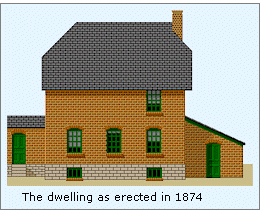 A
one and a half story brick dwelling rose behind the tower, connected
to the tower by means of an enclosed walkway. The first floor of the
dwelling contained a living room, kitchen, bedroom and an oil storage
room in which the precious fuel for the lamp was stored. The second
floor was completely allocated to sleeping areas. A brick lean-to for
wood storage attached to the rear of the dwelling and the construction
of a brick privy completed the station's structures. Being built of a
particularly hard and durable type of brick, the decision was made to
leave both the tower and ancillary structures in a natural, unpainted
condition, since it was expected they would withstand the rigors of the
weather without deterioration. This was no doubt a decision which sat
well with Keeper Davenport, as painting was an activity in which the
authorities held considerable stock, and he found himself in the
enviable position of not having that millstone around his neck every
year! A
one and a half story brick dwelling rose behind the tower, connected
to the tower by means of an enclosed walkway. The first floor of the
dwelling contained a living room, kitchen, bedroom and an oil storage
room in which the precious fuel for the lamp was stored. The second
floor was completely allocated to sleeping areas. A brick lean-to for
wood storage attached to the rear of the dwelling and the construction
of a brick privy completed the station's structures. Being built of a
particularly hard and durable type of brick, the decision was made to
leave both the tower and ancillary structures in a natural, unpainted
condition, since it was expected they would withstand the rigors of the
weather without deterioration. This was no doubt a decision which sat
well with Keeper Davenport, as painting was an activity in which the
authorities held considerable stock, and he found himself in the
enviable position of not having that millstone around his neck every
year!
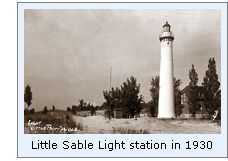 With the weather worsening, the crews
completed the project, and departed for the final time at the end of the
1873 season, leaving Keeper James Davenport to maintain the station
through the winter. With construction complete, it was found that the
costs of the project totaled-up to $28,886, saving the Government $6,114
from the original appropriation. With the weather worsening, the crews
completed the project, and departed for the final time at the end of the
1873 season, leaving Keeper James Davenport to maintain the station
through the winter. With construction complete, it was found that the
costs of the project totaled-up to $28,886, saving the Government $6,114
from the original appropriation.
Assistant Keeper J. Larky arrived in
April of the following year, and the light was exhibited for the first
time at the opening of 1874 shipping season.
In 1889, a barn was added to the
station, and in 1892 a circular 360
gallon oil storage tank was installed. The following year, the keepers
built a boat landing and boathouse on the shore.
It did not take long before mariners
began complaining that the natural brick coloration made the tower
difficult to see during daylight hours. As a result, the tower was painted white on September 24, 1900, and thereafter,
keepers assigned to the tower would be stuck with the drudgery of the
annual painting ritual.
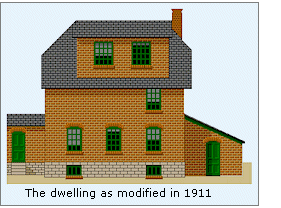 In 1902, a trail was opened-up to the
area, and wooden boardwalks were installed leading from the trail to the
station. With this improvement, it was possible to bring supplies to the
station by land. Also in this year, brick oil storage shed was
constructed. In 1911, in order to make room for one of the keeper's
growing family, dormers were added on both sides of the roof,
effectively adding a third floor to the building. In 1902, a trail was opened-up to the
area, and wooden boardwalks were installed leading from the trail to the
station. With this improvement, it was possible to bring supplies to the
station by land. Also in this year, brick oil storage shed was
constructed. In 1911, in order to make room for one of the keeper's
growing family, dormers were added on both sides of the roof,
effectively adding a third floor to the building.
In December 1954, with electrical power
extended to the station, the kerosene lamp was replaced with a 250-watt
electrical lamp within the Fresnel lens. At this time, the rotating
mechanism was also removed from the tower, giving the light a new fixed
characteristic.
With the station unmanned, the Coast
Guard began to see the ancillary buildings as a liability, and in the
first half of 1955 a crew arrived at the station and demolished
everything but the tower.
The tower remained in its white painted
condition until 1977, when once again seizing the opportunity to reduce the
ongoing maintenance costs associated with constant painting, a crew arrived at the
station, and sandblasted the tower. Once again, James Davenport's easy
ride was exposed to the light of day!
The 39 acres of the original station
are now part of the Silver Lake State Park, and a paved parking lot has
been constructed a short distance behind the dunes, giving bathers a
close path to the beach.
In early December 2005, the Big Sable Point Light
Keepers Association signed a twenty-five year lease on the tower, and
the group began rehabilitation in the spring of 2006. The tower ill be
open to the public from 10.00 AM to 6.00 PM every Friday through Monday
from the first weekend in June through the end of August.

Keepers of this Light

Click Here
to see a complete listing of all Little Sable Point Light keepers
compiled by Phyllis L. Tag of Great Lakes Lighthouse Research.

Seeing this
Light

Take Silver Lake Road South out of Silver Lake. Near the Lake, the road
turns to the West and the road surface changes to gravel. Continue on
this gravel road approximately 1/2 mile to the lighthouse parking area.
Climb over the dune, and the tower is on the beach on the Lake side of
the dune.

Contact information

Big Sable Point Lighthouse Keepers Association
P.O. Box 673
Ludington, MI 49431

Reference Sources

Inventory of Historic Light
Stations, National Parks Service 1994 .
Little Sable Point, Tomas A. Tag, 1996
Photographs from author's personal collection.
Personal observation at Little Point Sable. 09/13/1998
Historical image from USCG Historians office, Photographic archives.
Keeper listings for this light appear courtesy of Great
Lakes Lighthouse Research
|
